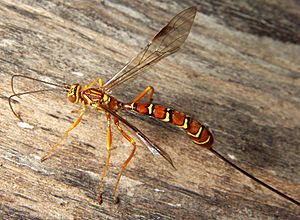Ichneumon facts for kids
Quick facts for kids Ichneumonoidea |
|
|---|---|
 |
|
| Megarhyssa macrurus female | |
| Scientific classification | |
| Kingdom: | |
| Phylum: | |
| Class: | |
| Order: | |
| Suborder: | |
| Superfamily: |
Ichneumonoidea
Latreille, 1802
|
| Families | |
|
|
The Ichneumonoidea are a very large group of parasitoid wasps. They are a "superfamily" of insects, which is a big grouping in how scientists classify living things. These wasps belong to the Apocrita suborder. This means they are related to other well-known insects like ants and bees.
Contents
Ichneumon Wasps: Nature's Tiny Helpers
This superfamily includes two main families: the ichneumon wasps (family Ichneumonidae) and the braconids (family Braconidae). Together, there are more than 80,000 different species of these wasps! Ichneumon wasps are usually bigger than braconids. They also have about three times as many species. Scientists mostly tell the two families apart by looking closely at the veins in their wings.
Amazing Adaptations
Almost all ichneumonoid wasps live alone. Most of them are parasitoids. This means their young, called larvae, grow by feeding on or inside another insect. Sadly for the host insect, it usually dies when the wasp larva is ready to grow into its next stage.
Many species in both families use special "polydnaviruses." These viruses help the wasps by weakening the host insect's defenses. This makes it easier for the wasp larvae to grow inside them.
How They Help Us
Some ichneumon wasps can use many different kinds of insects as hosts. Others are very picky and only choose one specific type of host. Because of this, many ichneumon wasps are used by people to help control pests. They are like natural "biological control agents." They can help farmers by reducing the number of harmful insects, such as certain flies or beetles, without using chemicals.
Life Cycle and Reproduction
Ichneumon wasps come in many sizes. They can be as small as 3 millimetres (0.12 in) (about the size of a tiny ant) or as long as 130 mm (5.1 in) (which is about 5 inches!). Most of them have slender bodies.
The females of many species, especially in the Megarhyssa group, have a very long part called an ovipositor. This long tube is used for laying eggs. It might look scary, but it does not sting like a bee or a regular wasp. Instead, the female wasp uses her ovipositor to find a host insect. She then lays an egg on, near, or inside the host's body.
When the egg hatches, the tiny wasp larva starts to feed. It might feed on the outside or inside of the host. The larva keeps eating until it is ready to change into a pupa. At this point, the host insect usually dies. Some wasps can even use their ovipositor to drill through rotten wood. This helps them find grubs hiding under the wood and lay their eggs there.
See also
- An interesting account of an observer's encounter with Ichneumons.
 In Spanish: Ichneumon para niños
In Spanish: Ichneumon para niños

